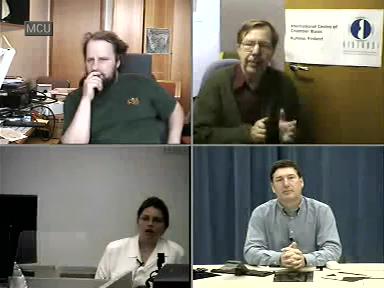
This is Donner's part of a module focused on video conference based music theory teaching at the Syllabus Conference on July 20. 2003 in San José and the Internet. The paper was presented together with Frank Clark and Matti Ruippo. This segment of the paper starts right after an introduction of the presenters made by Jennifer Sterling from IUPUI.
That was not exactly 'La negra tomasa' or 'Eso que anda', but Matti Ruippo and the Hand Sign Video Conference Assistant — one of the tools I have developed to amplify the work of the Syllabus special group concentrating on Music Theory.
I hope that this module can set a good example of how video conferences enable music theory teaching over a distance. The team members have experienced some fascinating multi-cultural interchange and increase of pedagogical skills - not to speak about the growth of new abilities to handle Trans-Atlantic collaboration.
The cooperation was initiated by one of our partners, Fred Rees from IUPUI who suggested that Frank Clark from Georgia Institute of Technology, Matti Ruippo from the Sibelius Academy and Philip Donner from Virtuosi in Finland should establish a team cooperating in the development of pedagogical skills for music theory distance education. He wanted us to prepare a discussion material for the Syllabus Conference to be held in San José.
After some email handshakes, a video conference meeting was organized where the parties presented their experience and ambitions. Fred Rees proposed a conception whereby we would stress that the essence of our work is in the process: Some events would take place BEFORE, some DURING the Syllabus Conference, and some AFTER it. So we are actually right now somewhere in the MIDDLE of our collaboration.
Donner and Ruippo synthesized the early discussions into a plan of action and a tentative schedule. Quite quickly we were able to construct a methodology which has been easy enough to understand and to follow. Here are the main elements of our undertaking:
A good project should preferably also include some methodological development. As to the procedures that evolved during our work, I would like to mention the following approaches:
I assume that any serious research and development focusing on pedagogical use of video conferences should take at least these aspects into consideration. Let's have a look at a clip which illustrates the last aspect of our work. It is a multipoint conference in so called continuous presence mode. In this setting all participants can continuously see one another. If one of the devices is a high end video conference unit this configuration is easy to set up and to record.
Frank's view at the end of the clip somehow begs for further explanation. So Frank Clark, could you please make your points on the substance of our sessions and maybe on some of the problems of intercultural education.
Here Frank Clark starts his part of the presentation and after him Matti Ruippo makes his points.